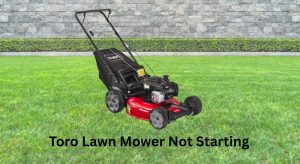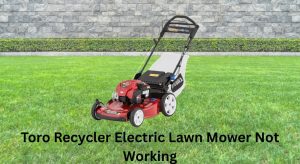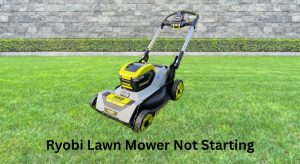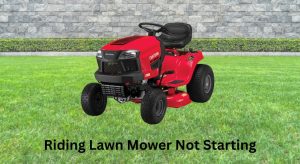Your lawn mower’s self-propel function suddenly stopped working and now you’re pushing it uphill—frustrating, right? The good news: most self-propel issues come down to simple maintenance like a loose drive cable, worn drive belt, or debris around the wheels. Quick fix: check and tighten the self-propel cable at the handle, clear grass buildup around the drive wheels, and inspect the drive belt for slipping or breakage.
In this complete guide, you’ll learn the most common causes of self-propel failures, step-by-step methods to diagnose and fix them for both front-wheel-drive (FWD) and rear-wheel-drive (RWD) mowers, plus maintenance tips to keep your mower pulling strong all season. By the end, you’ll know exactly how to get your lawn mower’s self propelled feature working again—without an expensive trip to the shop.
Common Causes of Lawn Mower Self Propelled Not Working
- Drive cable stretched or out of adjustment: The control cable from the handle to the transmission loosens over time, reducing engagement.
- Worn, broken, or slipping drive belt: The belt connecting the engine pulley to the transmission can fray, crack, or glaze and slip.
- Debris clogging the drive wheels/axle: Grass and twigs can bind wheel gears or pawls, preventing engagement.
- Worn wheel gears or stripped drive teeth: Internal plastic/metal gears inside the wheel hub wear out.
- Faulty transmission/gearbox: The transaxle that turns the wheels may seize or fail internally.
- Drive clutch or idler pulley issues: The tensioner doesn’t engage the belt properly due to spring or pulley wear.
- Incorrect wheel height or mismatched tire pressure (on some models): Causes poor traction and slipping.
- Broken or missing key/pin in wheel hub: The drive key that locks the wheel to the shaft fails.
- Wet grass or worn tires: Reduced traction—self-propel works, but wheels spin and don’t pull.
- Engine speed too low: Self-propel needs full throttle to engage effectively.
How to Fix a Self-Propelled Lawn Mower
Important: Disconnect the spark plug wire before working under the deck. If you have a battery mower, remove the battery. For gas models, shut off fuel and tip the mower carburetor-side up to avoid flooding.
Method 1: Quick Checks and Adjustments
Diagnosing the Issue
- Symptoms: Handle lever feels loose, mower moves slightly then stops, or wheels spin intermittently.
- Time: 10–20 minutes
- Tools: Gloves, pliers, flat brush, screwdriver
Fix Steps
- Inspect the self-propel cable at the handle:
– Squeeze the self-propel bar. The cable should tighten and move the bracket at the transmission.
– If slack, adjust using the inline adjuster (barrel adjuster or clamp) near the handle. Turn to shorten the cable housing, increasing tension. - Check cable movement at the transmission:
– Watch the end of the cable where it connects to the transmission or engagement arm. It should move fully when you press the handle.
– If the outer sheath has slipped, reseat it into its mount or clip. - Clean the drive wheels:
– Remove grass wrapped around axles and inside the wheel wells using a brush or pick.
– Spin wheels by hand; they should rotate smoothly with clicks on some models (ratcheting pawls). - Confirm throttle:
– Set engine to full throttle. Low RPM reduces belt tension and self-propel strength. - Check tire traction:
– If wheels are bald, wet, or muddy, clean them and mow when dry. Consider replacing worn wheels.
Testing
- Reconnect the spark plug or battery.
- Lift the rear or front slightly and engage self-propel briefly to confirm wheels turn.
- On flat ground, engage and walk—mower should pull without pushing.
Method 2: Replace or Re-tension the Drive Belt
Diagnosing the Issue
- Symptoms: Engine runs, but wheels don’t turn; burning smell; belt looks shiny, cracked, or frayed.
- Models: Common on Honda HRR/HRX, Toro Recycler, Craftsman, Troy-Bilt, Husqvarna, Yard Machines, and many others.
- Time: 30–60 minutes
- Tools: Socket set, pliers, scraper, replacement belt (match the OEM part number), manual or belt routing diagram
Fix Steps
- Prepare the mower:
– Disconnect spark plug/battery.
– Tip the mower carburetor up. Support securely. - Remove the blade cover/drive cover:
– Some models have a plastic belt guard under the deck; others require removing the front or rear drive cover.
– Remove debris thoroughly so you can see pulleys and idlers. - Inspect the belt path:
– Take a photo of the routing. Look for damaged idler pulleys or broken springs. - Remove the old belt:
– Slip it off the engine pulley and transmission pulley. You may need to loosen the idler or remove a guard. - Install the new belt:
– Route according to your photo/manual. Ensure the belt sits in pulley grooves and behind any belt keepers.
– Check idler pulley spins freely. Replace if noisy or wobbly. - Set belt tension:
– Some mowers auto-tension when you release the idler; others rely on proper cable tension.
– Ensure when the self-propel lever is squeezed, the belt tightens. - Reassemble covers and blade guard.
Testing
- Start mower at full throttle.
- Engage self-propel and walk forward. If it slips under load, readjust the cable or re-check belt routing.
Method 3: Wheel Gear and Pawl Service
Diagnosing the Issue
- Symptoms: One wheel drives, the other freewheels; clicking without movement; mower pulls to one side; wheels spin by hand but not under power.
- Time: 20–45 minutes
- Tools: Socket/wrench, flathead screwdriver, rag, light grease, replacement wheel gears/pins (model-specific)
Fix Steps
- Remove the drive wheels:
– Loosen the center bolt and pull off the wheel. - Inspect internal gears:
– Many mowers have a plastic gear inside the wheel that meshes with a pinion on the axle.
– Look for rounded or stripped teeth, broken pawls, or missing keys. - Clean and lubricate:
– Remove old grass, dust, and hardened grease.
– Apply a thin coat of light grease to gears—don’t pack heavily; excess attracts debris. - Replace worn parts:
– Swap in new wheel gears, keys, or pawls as needed. Ensure correct orientation for left/right wheels on ratcheting systems. - Reinstall wheels and torque bolts snugly.
Testing
- With the mower lifted, engage self-propel and confirm both wheels engage.
- On ground, the mower should track straight. If it pulls, inspect the opposite wheel’s gear.
Method 4: Transmission and Drive System Troubleshooting
Diagnosing the Issue
- Symptoms: Cable moves and belt spins, but wheels don’t; grinding noises from gearbox; seized axle; no engagement even with new belt.
- Time: 45–90 minutes
- Tools: Socket set, pliers, screwdriver set, replacement transmission or service kit (OEM), service manual
Fix Steps
- Verify external parts:
– Confirm the cable fully actuates the transmission arm.
– Inspect idler pulley, tension springs, and belt keepers for damage. - Check the transmission pulley:
– If pulley spins but axle doesn’t, internal gears may be stripped. - Remove and inspect the transmission:
– Detach drive cable, belt, and axle retainers.
– Check for broken gear teeth, missing snap rings, or dried, contaminated grease. - Replace or rebuild:
– Many walk-behind mower gearboxes aren’t designed for full rebuilds; replacement is common.
– Order the exact part by model and serial number. - Reassemble and set cable tension:
– Ensure smooth belt path and proper engagement.
Testing
- Run at full throttle, engage self-propel. The mower should move steadily without chatter or grinding.
How to Prevent Future Self-Propel Issues
- Clean under-deck and around wheel hubs after each mow to prevent debris binding.
- Replace drive belts every 2–3 seasons, sooner in sandy or heavy-use conditions.
- Adjust the self-propel cable at the start and mid-season.
- Keep engine at correct RPM: change air filter, spark plug, and fuel as per schedule to maintain power.
- Avoid mowing wet grass to reduce belt slip and wheel wear.
- Store the mower dry; avoid hanging or storing on the front unless the manufacturer approves it, to prevent belt distortion.
- Grease or lubricate wheel gears lightly each season (if applicable).
Pro Tips
- Mark belt routing before removal with a quick phone photo to avoid misalignment.
- If your mower has selectable speed, test at low, then medium speeds—if it only works at low, the belt or cable likely needs attention.
- Replace wheels in pairs to keep tracking straight and maintain equal traction.
- For Honda-style two-belt systems (blade and drive), confirm you’re replacing the correct belt; part numbers differ by deck size.
- Use OEM or high-quality belts; generic belts often stretch or glaze quickly and slip under load.
- If your mower drifts to one side, swap wheels left-right to diagnose a worn wheel gear vs. axle gear.
- Periodically check the idler pulley bearing. A squeal or wobble is a sign to replace it before it chews up your new belt.
When to Call a Professional
- The transmission makes grinding noises, or the axle is seized.
- You’ve replaced the belt and adjusted the cable, but the drive still doesn’t engage.
- The drive cable or engagement lever bracket is broken at the handle or transmission.
- You see oil leaking from a sealed transmission case.
- You’re uncomfortable tipping or disassembling the mower.
What to look for:
– Authorized service center for your brand (Toro, Honda, Husqvarna, Craftsman, Troy-Bilt, EGO, Greenworks).
– Clear estimate for parts and labor, and warranty on repairs.
Typical costs (varies by region/model):
– Drive belt: $15–$40 (+$60–$120 labor)
– Drive cable: $15–$35 (+$50–$100 labor)
– Wheel/gear set: $15–$40 per wheel
– Transmission: $80–$200 (+$100–$200 labor)
Warranty notes:
– Many new mowers have 2–3 year limited warranties. Drive system parts may be covered—check your manual and keep proof of purchase.
FAQ
Q: Why does my lawn mower self-propel only work intermittently?
A: Likely a stretched cable or slipping belt. Heat and debris can worsen slippage as you mow. Adjust the cable and clean the belt/pulleys; replace a glazed or cracked belt.
Q: My mower’s wheels spin in the air but not on the ground—what’s wrong?
A: That’s usually belt slippage under load or worn wheel gears. Replace the belt and inspect internal wheel gears for wear. Also check traction—bald tires or wet grass will slip.
Q: The mower pulls to one side when self-propel is engaged. How do I fix it?
A: One wheel’s gear or pawl may be worn. Inspect both wheels’ internal gears; replace the worn side. Also verify equal wheel height settings and matching tire wear.
Q: Can I spray lubricant on the belt to stop squealing?
A: No. Lubricants cause the belt to slip and deteriorate. Clean pulleys, replace the belt, and replace noisy idler pulleys instead.
Q: How tight should the self-propel cable be?
A: With the lever released, there should be slight slack. When fully engaged, the drive arm should move fully without excessive force. If the wheels creep when the lever is released, the cable is too tight.
Q: How often should I replace the drive belt?
A: Typically every 2–3 seasons, or sooner with heavy use. Replace immediately if you see cracks, fraying, glazing, or if it slips after proper adjustment.
Q: Is it safe to tip my mower to access the belt?
A: Yes, but always tip with the carburetor/air filter side up on gas models to avoid oil/fuel leaks. Remove the spark plug wire or battery first.
Q: My battery self-propel mower stopped pulling. Are the steps similar?
A: Yes—inspect and adjust the drive cable (if equipped), clean wheel hubs, and check the belt. Some cordless models use brushless drive motors—if the belt and gears are fine, the motor or controller may need service.
Alternative Solutions
If repairs exceed the mower’s value or parts are scarce, consider these alternatives:
| Solution | Pros | Cons | Best For |
|---|---|---|---|
| Replace with a new self-propelled mower | Warranty, efficient engines, improved drive systems | Higher upfront cost | Heavy users or older units with failed transmissions |
| Convert to push (remove belt) | Zero cost, keeps mower usable | More effort, slower mowing | Small flat lawns, temporary workaround |
| Upgrade wheels/tires | Better traction | Added cost, may not fix drive issues | Sloped or wet lawns needing extra grip |
Get Your Self-Propelled Mower Working Again
By following this guide, you have multiple proven ways to fix a lawn mower self propelled not working:
– Fast checks: cable adjustment, wheel cleaning, throttle at max
– Belt service: inspect, re-tension, and replace worn belts
– Wheel hub repair: replace worn gears, pawls, or keys
– Drive system fixes: idler pulleys, springs, and transmission replacement
Don’t let a stubborn drive rob you of your weekend. Work through the methods in order, and you’ll restore smooth, reliable self-propel performance without guesswork.
Have you fixed your mower’s self-propel? Share what worked for your model in the comments to help other readers. Found this helpful? Bookmark it for quick reference before the next mowing season.




